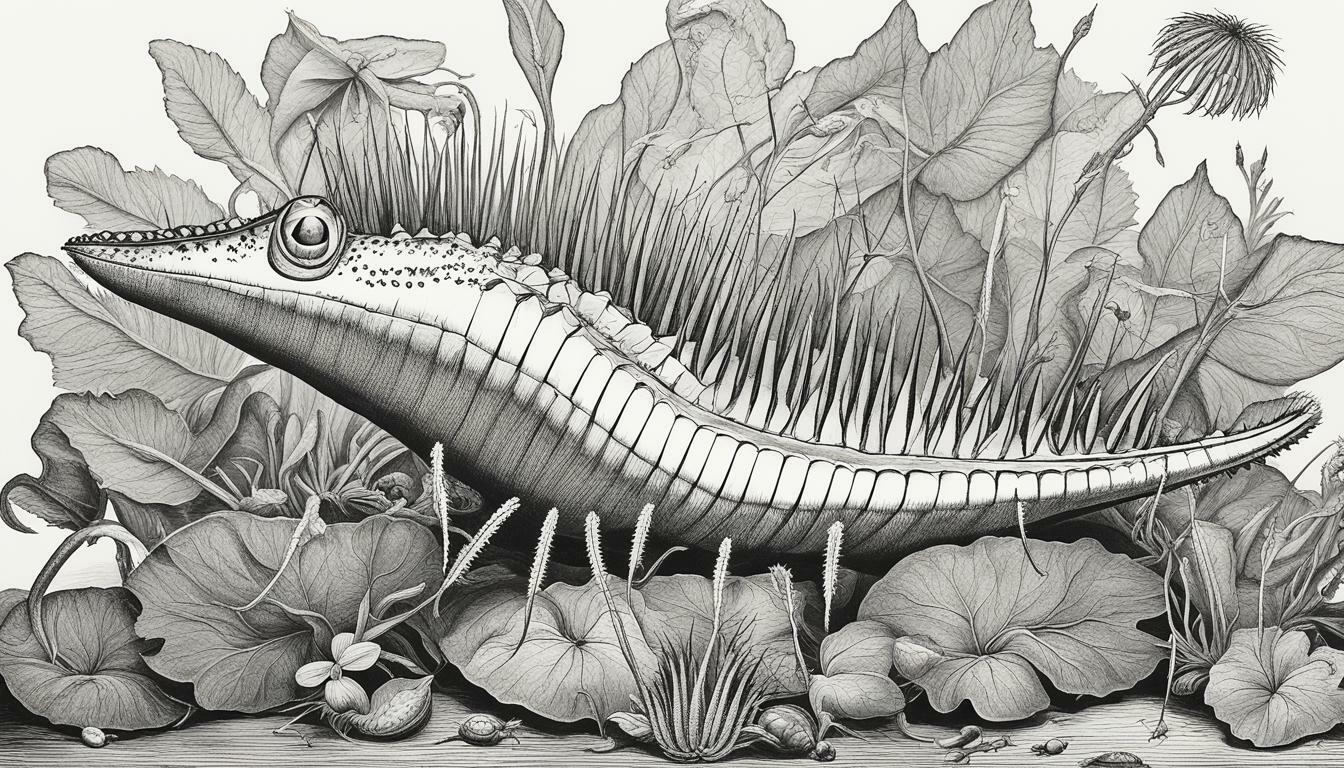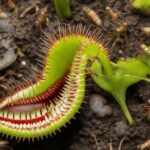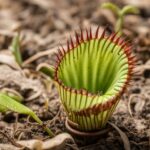Have you ever wondered if Venus flytraps attract other insects? These fascinating carnivorous plants have unique adaptations that allow them to capture and consume insects, but do they actively lure them in? In this section, we will explore the truth about Venus flytraps and their interactions with other insects.
Key Takeaways
- Venus flytraps are carnivorous plants that capture and consume insects.
- While they do not actively attract insects, their unique trap mechanism allows them to capture prey opportunistically.
- Venus flytraps rely on their natural habitat to provide an abundance of insects for them to capture.
The Carnivorous Nature of Venus Flytraps
To understand whether Venus flytraps attract other insects, it’s essential to know their carnivorous nature. These plants have specially adapted leaves with hinged traps adorned with sensitive trigger hairs. When an insect touches these hairs multiple times, the trap snaps shut, ensnaring the victim. This mechanism suggests that Venus flytraps are actively luring insects as bait for their diet.
Venus flytraps can distinguish between live prey and non-edible items, refusing to waste energy on inedible items. Some insects, however, can stimulate the trap without providing enough energy to justify the plant’s digestive process, leading to wasted energy.
| Important to note | The Venus flytrap’s trap will close in around 0.1 seconds, making it one of the fastest movements in the plant kingdom. |
|---|
Their carnivorous nature is what makes Venus flytraps so fascinating to observe. By actively hunting and capturing prey, these plants have developed unique adaptations to thrive in nutrient-poor environments.
However, despite their carnivorous ways, Venus flytraps do not intentionally attract insects through visual allure or pheromones. They rely solely on their trigger hair mechanism to capture prey, making their existence no more or less alluring to insects than the surrounding plants.
Venus Flytraps: A Deceptive Display
Despite their unique appearance, Venus flytraps do not intentionally attract other insects through visual allure or emit enticing scents. Instead, these carnivorous plants rely solely on their unique trap mechanism to capture prey. The trap is adorned with sensitive trigger hairs, and when an insect touches these hairs multiple times, the trap snaps shut, ensnaring the victim.
While the appearance of Venus flytraps may suggest otherwise, these plants are not actively trying to entice other insects towards them. In fact, they do not produce dazzling colors or emit enticing scents to lure unsuspecting insects. Instead, they rely on opportunistic capture rather than intentional attraction.
So, despite their reputation as insect magnets, Venus flytraps do not actively lure other insects through visual allure, chemical signals, or other means. Their presence may attract insects, but this is simply a result of their natural habitat and not a deliberate effort by the plants.
Do Venus Flytraps Emit Pheromones?
If you’re wondering if Venus flytraps actively lure other bugs through chemical signals, you might be surprised to know that there is limited evidence suggesting that Venus flytraps produce pheromones to attract prey. Some studies have detected volatile organic compounds released by these plants, but their role in attracting insects remains uncertain.
It’s important to note that while some carnivorous plants use pheromones to lure insects, the absence of strong evidence in Venus flytraps suggests that they may not heavily rely on chemical signals for hunting. Instead, these plants rely on their unique trap mechanism and opportunistic capture.
So, to answer the question, “Do Venus flytraps lure other bugs?” The answer is not through pheromones or intentional attraction, but through their physical traps and the presence of insects in their natural habitat.
Venus Flytraps and the Insect Hunt
Once the trap of a Venus flytrap closes upon capturing an insect, the plant secretes digestive enzymes to break down the insect’s soft tissues. The plants then absorb the nutrients released from the prey. This unique hunting strategy allows Venus flytraps to thrive in nutrient-poor environments.
The absence of active insect attraction further supports the idea that these plants rely on opportunistic capture rather than actively attracting insects. Their hunting strategy is based on the trigger hair mechanism on their leaves, which snaps shut when an insect brushes against it multiple times.
Therefore, Venus flytraps do not actively charm or lure other insects, but their unique hunting strategy ensures that they obtain the nutrients needed to survive in their natural habitat.
Venus Flytraps and Their Natural Habitat
Venus flytraps are carnivorous plants that are native to the wetlands of the southeastern United States. Their natural habitat provides an abundance of insects for these plants to capture, such as ants, beetles, spiders, and other small arthropods. The presence of these insects in the vicinity of Venus flytraps is simply a result of their natural habitat rather than an intentional attraction by the plants.
The wetland environment also plays an essential role in the survival of Venus flytraps. These plants require relatively moist soil and a high level of humidity to thrive. They are typically found in nutrient-poor environments, such as bogs and swamps, where they have evolved to capture and consume insects as a source of nutrients.
Despite their unique hunting strategy and carnivorous nature, Venus flytraps do not actively attract other insects to their location. Instead, they rely on their sensitive trigger hairs and trap mechanisms to capture prey opportunistically. The presence of insects near Venus flytraps is merely a consequence of their natural habitat and not a deliberate effort by the plants to lure insects.
In conclusion, while Venus flytraps are fascinating plants that capture and consume insects, they do not actively attract them. The presence of insects near these plants is simply a result of their natural habitat. Therefore, if you encounter Venus flytraps in the wild, don’t worry about attracting insects to your location as you admire these unique carnivorous plants.
Conclusion
After exploring the fascinating world of Venus flytraps, we can conclude that these carnivorous plants do not actively attract other insects. Their unique trap mechanism and opportunistic capture allow them to consume insects, but they do not rely on visual allure or pheromone release to lure their prey. Instead, the presence of insects near Venus flytraps is a natural consequence of their habitat. So, if you were wondering whether Venus flytraps attract other insects, the answer is no. These plants are simply fascinating and impressive in their ability to hunt and thrive in nutrient-poor environments.
Can Venus Flytraps Survive Without Attracting Other Insects?
Venus flytraps and their survival depend on attracting other insects. These carnivorous plants trap and consume small prey to extract nutrients from them. Without attracting insects, the flytraps may struggle to obtain the vital nutrients they need to thrive. These fascinating plants have adapted to their environment by attracting insects with their unique trapping mechanism, ensuring their survival in the wild.
FAQ
Q: Do Venus Flytraps attract other insects?
A: No, Venus Flytraps do not actively attract other insects. They rely on their unique trap mechanism and opportunistic capture rather than visual allure, pheromone release, or intentional attraction.
Q: What is the carnivorous nature of Venus Flytraps?
A: Venus Flytraps have specially adapted leaves with hinged traps adorned with sensitive trigger hairs. When an insect touches these hairs multiple times, the trap snaps shut, ensnaring the victim. This indicates that Venus Flytraps are actively luring insects as bait for their diet.
Q: Do Venus Flytraps emit pheromones to attract insects?
A: There is limited evidence suggesting that Venus Flytraps produce pheromones to lure insects. While some studies have detected volatile organic compounds released by these plants, their role in attracting insects remains uncertain.
Q: How do Venus Flytraps capture and consume insects?
A: Once the trap of a Venus Flytrap closes upon capturing an insect, the plant secretes digestive enzymes to break down the insect’s soft tissues. The plants then absorb the nutrients released from the prey.
Q: Where are Venus Flytraps typically found?
A: Venus Flytraps are native to the wetlands of the southeastern United States. Their natural habitat provides an abundance of insects for these plants to capture. The presence of insects in the vicinity of Venus Flytraps is simply a result of their natural habitat rather than an intentional attraction by the plants.











